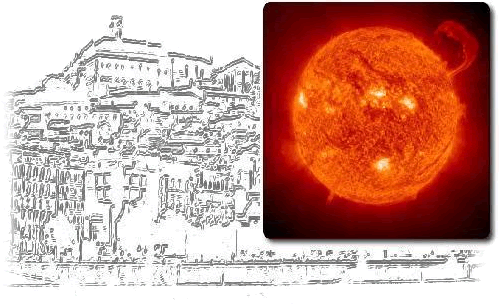|
|
|
|
|
|
|
|
|
|
|
|
|
Ioannis Kontogiannis, Mr. - PhD |
|
Institute for Astronomy, Astrophysics, Space Applications and Remote Sensing, National Observatory of Athens, Penteli, Greece |
|
http://www.astro.noa.gr/en/staff/cv.php?staff=postdocs&id=kontogiannis |
|
|
|
|
|
Session 1 - Speaker |
|
A study of a quiet solar network region structure and dynamics using ground and space based observations |
|
I. Kontogiannis, G. Tsiropoula, K. Tziotziou (National Observatory of Athens) and C. Gontikakis (Academy of Athens) |
|
|
|
We present a detailed study of a very quiet solar region, using data from
an observational campaign that involved ground based and space born instruments. The
region was observed by the Dutch Open Telescope, the XRT, SOT and EIS instruments
onboard Hinode, TRACE and the MDI onboard SoHO. This combination of instruments
offers a complete tomographic view of the atmospheric layers from the photosphere to
the corona and allows a) the determination of its magnetic and temperature structure
b) the correspondence between fine structure and jet-like events at different
atmospheric heights c) the study of wave propagation through the atmospheric layers.
A calculation of the current-free magnetic field vector up to the corona shows that
the network structure persists up to coronal temperatures and consists of a
multitude of flux tubes that connect to different network and internetwork areas and
reach different heights and temperatures. At least some of the jet like structure
s observed in the Hα line, around the network, have a counterpart in the
overlying atmosphere. We study their evolution in the different atmospheric
heights/temperatures. We also determine the height of the magnetic canopy, the
interface between the completely magnetized plasma of the chromosphere/transition
region and the underlying photosphere. The distribution of the power of the
acoustic oscillations and its dependence on the inclination of the magnetic field
shows that, at the height of the magnetic canopy, acoustic waves undergo conversion
and transmission. This finding is also supported by the measured phase differences
between oscillations at different heights. Fast waves reflect at the turning height
and form standing waves while slow waves propagate along the slanted magnetic field
lines of the network. |
|
|
|
|
|
|
|




 









 |



